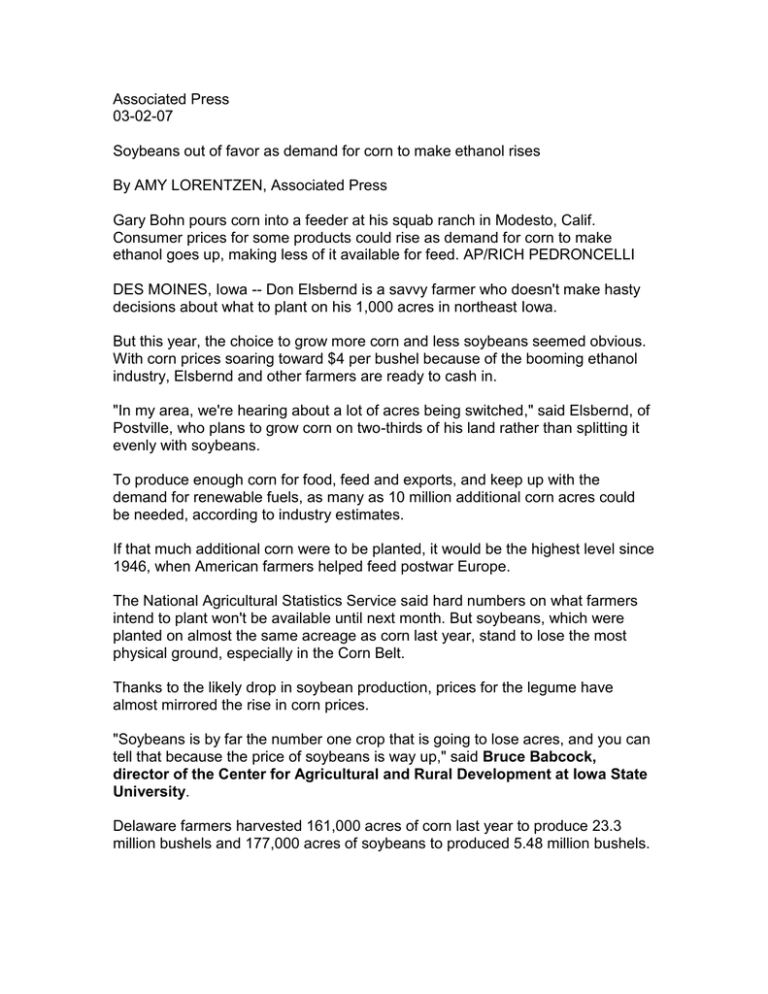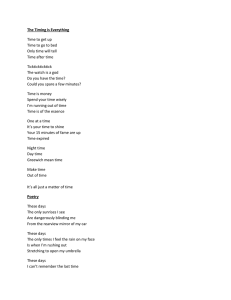Associated Press 03-02-07
advertisement

Associated Press 03-02-07 Soybeans out of favor as demand for corn to make ethanol rises By AMY LORENTZEN, Associated Press Gary Bohn pours corn into a feeder at his squab ranch in Modesto, Calif. Consumer prices for some products could rise as demand for corn to make ethanol goes up, making less of it available for feed. AP/RICH PEDRONCELLI DES MOINES, Iowa -- Don Elsbernd is a savvy farmer who doesn't make hasty decisions about what to plant on his 1,000 acres in northeast Iowa. But this year, the choice to grow more corn and less soybeans seemed obvious. With corn prices soaring toward $4 per bushel because of the booming ethanol industry, Elsbernd and other farmers are ready to cash in. "In my area, we're hearing about a lot of acres being switched," said Elsbernd, of Postville, who plans to grow corn on two-thirds of his land rather than splitting it evenly with soybeans. To produce enough corn for food, feed and exports, and keep up with the demand for renewable fuels, as many as 10 million additional corn acres could be needed, according to industry estimates. If that much additional corn were to be planted, it would be the highest level since 1946, when American farmers helped feed postwar Europe. The National Agricultural Statistics Service said hard numbers on what farmers intend to plant won't be available until next month. But soybeans, which were planted on almost the same acreage as corn last year, stand to lose the most physical ground, especially in the Corn Belt. Thanks to the likely drop in soybean production, prices for the legume have almost mirrored the rise in corn prices. "Soybeans is by far the number one crop that is going to lose acres, and you can tell that because the price of soybeans is way up," said Bruce Babcock, director of the Center for Agricultural and Rural Development at Iowa State University. Delaware farmers harvested 161,000 acres of corn last year to produce 23.3 million bushels and 177,000 acres of soybeans to produced 5.48 million bushels. Rick Ostlie, president of the American Soybean Association, predicts up to 5 million acres of soybeans could be replaced with corn nationwide. He believes it will be a short-term impact because "a lot of the land we grow soybeans on would not be suitable for corn." "Logistics will cause people to keep on planting their soybeans," said Ostlie, who grows about 2,000 acres of soybeans in Northwood, N.D. Corn prices have climbed as high as $4.08 per bushel recently. Last year at the same time, they hovered around $2.22. Soybean prices also are climbing, with March soybean futures priced at $7.59 compared to $5.87 a year ago, a 29 percent increase, Babcock said. While corn costs more to produce because of higher seed, fertilizer, equipment, transportation and storage costs, fluctuating estimates show that corn can earn hundreds of dollars more per acre compared to soybeans, said Corinne Alexander, an agricultural economics professor at Purdue University. Much of the difference is because corn has a higher yield than soybeans -- an average of about 50 bushels per acre of soybeans compared to 150 bushels per acre of corn, Alexander said. Also affecting farmers' planting choices are record-ending stocks of soybeans, about 595 million bushels this year, or about 20 percent of what the nation uses each year, Alexander said. Ending stocks on corn are only at 752 million bushels, or 6.4 percent of usage. "The last time we got down to this ratio ... corn futures went above $5," she said. Staff reporter Luladey B. Tadesse contributed to this article.





